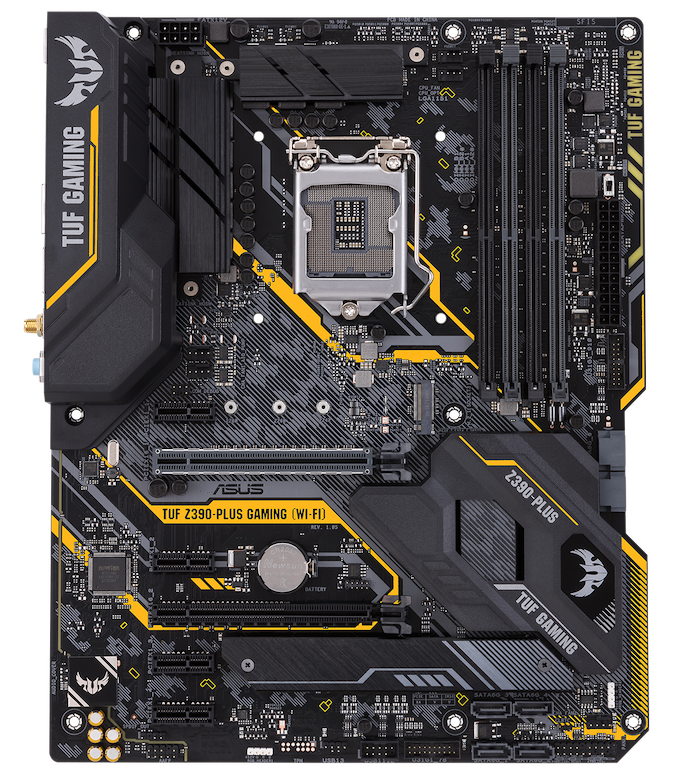Intel Z390 Motherboard Overview: 50+ Motherboards Analyzed
by Ian Cutress & Gavin Bonshor on October 8, 2018 10:53 AM EST- Posted in
- Motherboards
- Intel
- MSI
- Gigabyte
- ASRock
- EVGA
- Asus
- NZXT
- Supermicro
- Z390
ASUS TUF Z390 Plus Gaming
ASUS TUF Z390 Plus Gaming Wi-Fi
The TUF Z390 Plus Gaming and the Wi-Fi inclusive TUF Z390 Plus Gaming Wi-Fi are a pair of ATX sized motherboards which sits just below the TUF Z390 Pro Gaming in the current Z390 product stack from ASUS. The main difference in specification between the Pro Gaming and the Plus gaming is that this model has no support for two-way SLI due to bandwidth restrictions on the second full-length PCIe slot. The PCIe 3.0 slot configuration on the Z390 Plus Gaming and Wi-Fi enabled model is slightly different with two full-length PCIe 3.0 lanes with the top operating at x16 and the second at just x4; this is in addition to four PCIe 3.0 x1 slots.
Visually the boards have an all-black look with black rear panel covers and black heatsinks; a lot of blacks but this is offset with yellow colored TUF gaming accenting across the heatsinks and around the PCB of the socket area. The TUF Z390 Plus Gaming and Plus Gaming Wi-Fi have two PCIe 3.0 x4 M.2 slots with the bottom slot having a heatshield integrated on the board; only one of the M.2 slots has support for SATA drives. A total of six SATA ports is also present with support for RAID 0, 1, 5 and 10 arrays.

ASUS TUF Z390 Plus Gaming Wi-Fi rear panel (only difference is wireless support)
The rear panels on both models include two USB 3.1 Gen2 Type-A and four USB 3.0 Type-A ports, with a pair of video outputs consisting of a DisplayPort and HDMI. Two separate PS/2 ports for a keyboard and mouse are included as well as an Intel I219V Gigabit powered LAN port and three 3.5 mm audio jacks taking their direction from a Realtek S1200A HD audio codec. The only difference between both models comes with a pair of antenna connectors provided by an Intel 9560 2x2 MU-MIMO Wave 2 Wi-Fi adapter.
The ASUS TUF Z390 Plus Gaming has an MSRP of (INSERT PRICE) and occupies the entry-level segment of the gaming based market. The more expensive TUF Z390 Plus Gaming Wi-Fi costs (INSERT PRICE) with the premium clearly attributed to the included Intel 9560 1.73 Gbps capable Wi-Fi adapter. Both look attractive at their respective price points and users have the option with or without Wi-Fi capability.











79 Comments
View All Comments
pawinda8 - Monday, October 15, 2018 - link
Still no mention of any Z390 boards with native Thunderbolt 3 (not AIC)! Has Intel given up on Thunderbolt for the PC world?gavbon - Monday, October 15, 2018 - link
If it's not integrated into the chipset, it's not really native as such. The ASRock Z390 Phantom Gaming-ITX/ac has a Thunderbolt 3 port on the rear panel, but that's the only one I'm afraidHikariWS - Monday, October 15, 2018 - link
Oculus Rift requires 3 USB3 ports and doesn't accept any of them being connected to a hub, they all need to be connected directly into a raw port. I had to buy a dedicated 3GIO USB 3 board that added 6 useful extra ports. In my (yes, old) Gigabyte z87 mobo I also had issues using keyboard and mouse on USB 3 ports inside UEFI and some recovery softwares, so I had to buy a USB 2 mirror to connect them.Because of that, having USB 2 ports on front panel and nice quantity of USB 3 is what most differs mobos for me, given that all other features are nearly the same.
ASUS Z390-A seems to be the best option. It has the important double USB2 ports, 5 USB3 ports and still has HDMI and DP for emergencies.
just4U - Monday, October 15, 2018 - link
I wish MSI had released a "godlike" board for the Ryzen series.ThugEsquire - Tuesday, October 16, 2018 - link
You list the ASRock Z390 Phantom Gaming-ITX/ac above as an ATX board, but it's actually mITX. FYIgavbon - Friday, October 19, 2018 - link
I have gone through every page where the Phantom Gaming-ITX/ac is listed, but I can't see where it says it's an ATX board? Could you please be more specific? Are you viewing on mobile or desktop?Galcobar - Tuesday, October 16, 2018 - link
It would be really helpful to break out one more criteria into a table: Type-C header for case-front ports.Helping a friend put together an i5 system and, knowing he'll keep it for a long time, am trying to get even with peripheral connectors (already has a monitor, so no using that as a hub). It's relatively easy to identify cases with a Type-C port, but that's pointless without a motherboard header. Having to go into each board's page to check is time-consuming.
jjnam - Thursday, April 18, 2019 - link
6 months later and I'm here for EXACTLY this reason. I've gone through probably 50 manuals over the past few days squinting to find this information. What a pain.Synomenon - Thursday, October 18, 2018 - link
So on the ASRock Z390 Phantom Gaming-ITX/ac, is the TB3 port on the rear using up lanes from CPU (making the only 16x slot, 8x only)?If it's not using lanes from the CPU, how will using that TB3 port (say with a USB3.1 Gen2 hub OR TB3 hub) affect all the other ports / IO on the board?
repoman27 - Thursday, October 18, 2018 - link
Going off of what TweakTown published, it's a single-port Intel JHL6240 "Alpine Ridge" controller with a PCI 3.0 x2 connection to the PCH. So it won't affect the PEG lanes from the CPU. I'm amazed it's not Titan Ridge at this point though.